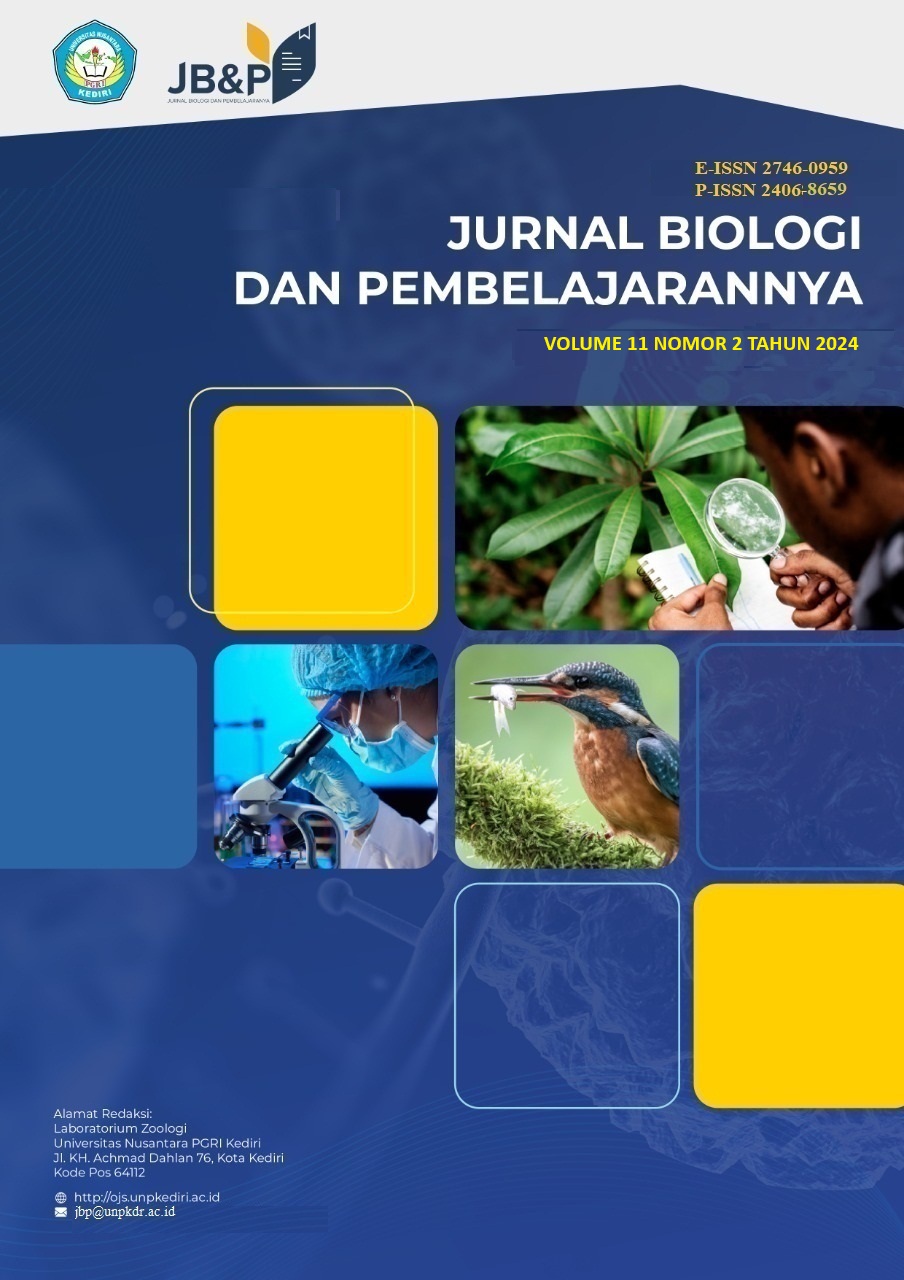Analisis Pengaruh Tujuan Pembelajaran yang Jelas Terhadap Ketercapaian Pembelajaran Biologi Siswa SMA
DOI:
https://doi.org/10.29407/jbp.v11i2.22838Keywords:
Biologi, Pembelajaran, TujuanAbstract
Learning objectives are defined as statements that specify the goals to be achieved in the learning process. The learning objectives of biology in schools are mainly centered on improving students' ability to think critically, creatively, and analytically as well as increasing their understanding of the benefits of biology in everyday life. This research takes a qualitative approach by using the literature study method as its main foundation. The main focus of the research is to explore an in-depth understanding of the relationship between learning objectives and their achievement for biology learning in high school. The data analysis process is carried out systematically to classify information, identify, and synthesize the findings obtained from the literature studied.The purpose of learning design is to improve the quality and effectiveness of the teaching and learning process. This can be achieved by selecting, determining and developing the most appropriate and optimal learning methods based on the needs and characteristics of students, the learning objectives to be achieved and the resources available. A good learning design will ensure that the learning process runs smoothly and achieves the desired results. Clear learning objectives have a significant influence on the achievement of biology learning in high school students. The formulation of clear biology learning objectives and teachers' efforts to realize them are important factors in improving the quality and achievement of biology learning in high school students.
References
Agustina, P., Saputra, A., Anif, S., Rayana, A., & Probowati, A. (2021). Analisis keterampilan proses sains dan sikap ilmiah siswa kelas XI IPA SMA pada praktikum biologi. EduSains, 13(1), 1-7.
Anzelina, D. E. (2023). Potensi kearifan lokal sumatera selatan sebagai basis media pembelajaran kontekstual biologi SMA. Journal of Nusantara Education, 2(2), 53-63.
Asmara, Y., & Nindianti, D. S. (2019). Urgensi Manajemen Kelas untuk mencapai tujuan pembelajaran. Sindang: Jurnal Pendidikan Sejarah dan Kajian Sejarah, 1(1), 12-24.
Asrori, M. (2013). Pengertian, Tujuan dan Ruang Lingkup Strategi Pembelajaran. Madrasah, 5(2).
Faradiba, A. dan Perdana, P.I. (2024). Analisis Perumusan Tujuan Pembelajaran Pada Modul Ajar Bahasa Indonesia Kurikulum Merdeka Belajar. Journal of Education for All, 2(1):37-48.
Goss, P., Sonnemann, J., & Griffiths, K. (2017). Engaging Students: Creating Classrooms That Improve Learning.
Hanifah, H., Susanti, S., & Adji, A. S. (2020). Perilaku dan karateristik peserta didik berdasarkan tujuan pembelajaran. Manazhim, 2(1), 105-117.
Hendratmoko, T., Kuswandi, D., & Setyosari, P. (2017). Tujuan Pembelajaran Berlandaskan Konsep Pendidikan Jiwa Merdeka Ki Hajar Dewantara. Jurnal Inovasi dan Teknologi Pembelajaran, 3(2), 152-157.
Imania, K. A. N., & Bariah, S. K. (2019). Rancangan pengembangan instrumen penilaian pembelajaran berbasis daring. Petik: Jurnal Pendidikan Teknologi Informasi dan Komunikasi, 5(1), 31-47.
Jazilurrahman, J., Fajri, Z., & Munir, M. (2024). Penerapan Media Pembelajaran Berbasis Video Kreatif Dalam Meningkatkan Prestasi Belajar PAI. Pendas: Jurnal Ilmiah Pendidikan Dasar, 9(1), 2671-2689.
Lazwardi, D. (2017). Implementasi evaluasi program pendidikan di tingkat sekolah dasar dan menengah. Al-Idarah: Jurnal Kependidikan Islam, 7(2), 142-156.
Magdalena, I. (2021). Desain Instruksional SD (Teori dan Praktik). Sukabumi: CV Jejak (Jejak Publisher).
Mursyid, A., Ahmad, C. F., Dewi, A. K., & Tianti, A. Y. (2023). Penerapan kurikulum merdeka dalam rencana pelaksanaan pembelajaran di Purwakarta. Al-Fahim: Jurnal Manajemen Pendidikan Islam, 5(1), 173-187.
Rahmalia, S. M., & Sabila, N. D. (2024). Perencanaan Pembelajaran: Pengertian, Fungsi Dan Tujuan. Karimah Tauhid, 3(5), 6014-6023.
Priyayi, D. F., Keliat, N. R., & Hastuti, S. P. (2018). Masalah dalam pembelajaran menurut perspektif guru biologi sekolah menengah Atas (SMA) di Salatiga dan Kabupaten Semarang. Didaktika Biologi: Jurnal Penelitian Pendidikan Biologi, 2(2), 85-92.
Rohmawati, O., Poniyah, P., & Adiyono, A. (2023). Implementasi Supervisi Pendidikan Sebagai Sarana Peningkatan Kinerja Guru Dalam Kegiatan Belajar Mengajar. Jurnal Pendidikan Dan Keguruan, 1(3), 108-119.
Sahmiatik, E., Basri, H., Latipah, E., (2022). Meningkatkan Tujuan Pembelajaran Siswa dengan Konsep Pilar Pendidikan Unesco di Era Merdeka Belajar. JIKAP PGSD: Jurnal Ilmiah Ilmu Kependidikan, 6(2).
Saifulloh, A. M., & Darwis, M. (2020). Manajemen pembelajaran dalam meningkatkan efektivitas proses belajar mengajar di masa pandemi covid-19. Bidayatuna Jurnal Pendidikan Guru Mandrasah Ibtidaiyah, 3(2), 285-312.
Sanasintani, S. (2022). Pembinaan Profesional Guru Pendidikan Agama Kristen Melalui Supervisi Klinis. Jurnal Teologi Berita Hidup, 5(1), 39-55.
Shodiq, S. F. (2019). Revival Tujuan Pembelajaran Pendidikan Agama Islam (Pai) Di Era Revolusi Industri 4.0. At-Tajdid: Jurnal Pendidikan Dan Pemikiran Islam, 2(02), 216-225.
Sonia, T., Alberida, H., Arsih, F., & Selaras, G. H. (2023). Pengaruh Model Pembelajaran Inkuiri Terbimbing Terhadap Keterampilan Berpikir Kritis Peserta Didik Pada Pembelajaran Biologi. Bioilmi: Jurnal Pendidikan, 9(1), 78-86.
Suharti, A. (2022). Perencanaan Pembelajaran (kurikulum merdeka). Banten : Sada Kurnia Pustaka.
Wahyuni, S. (2022). Kurikulum merdeka untuk meningkatkan kualitas pembelajaran. Jurnal Pendidikan Dan Konseling (JPDK), 4(6), 13404-13408.
Downloads
Published
Issue
Section
License
Authors who publish with this journal agree to the following terms:
- Copyright on any article is retained by the author(s).
- The author grants the journal, right of first publication with the work simultaneously licensed under a Creative Commons Attribution License that allows others to share the work with an acknowledgment of the work’s authorship and initial publication in this journal.
- Authors are able to enter into separate, additional contractual arrangements for the non-exclusive distribution of the journal’s published version of the work (e.g., post it to an institutional repository or publish it in a book), with an acknowledgment of its initial publication in this journal.
- Authors are permitted and encouraged to post their work online (e.g., in institutional repositories or on their website) prior to and during the submission process, as it can lead to productive exchanges, as well as earlier and greater citation of published work.
- The article and any associated published material is distributed under the Creative Commons Attribution-ShareAlike 4.0 International License













